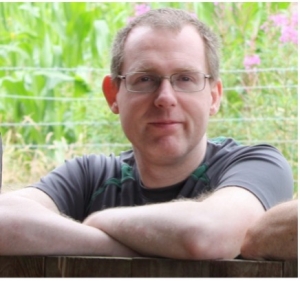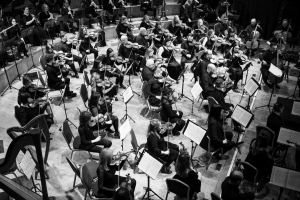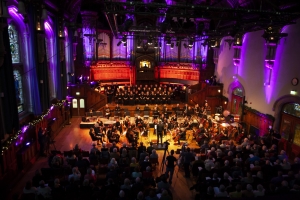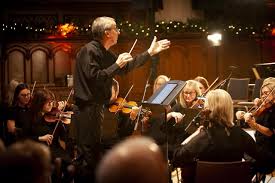IRISH DOCTORS CHOIR PRESENTS
Of Night and Light
with Gareth Lewis Organ & Piano
and
Irish Doctors Orchestra String Quartet
DIRECTED BY BRIAN MacKAY
O Radiant Dawn – James MacMillan
Dark Night of the Soul – Ola Gjeilo
Tread Softly – Mark Armstrong
Allegretto in F Opus 101 N0 1 – CV Stanford
Toccata in G Major- T Dubois
Sure on this Shining Night – Morten Lauridsen
Sun on Water- Hussein Janmohammed
Agnus Dei – Samuel Barber
Of Night and Light
Darkness and light are appropriate themes for an Advent concert, a reflection of how the point of most intense darkness holds the promise of the coming of the light. The interplay between light and dark has been a focus of inspiration for poets and composers for millennia, the dark epitomising the challenges, travails and doubts of life, the light the possibilities, hope and opportunities that balance human existence.
Inspired by the words of William Butler Yeats, Irish Doctors Choir invite you to join them on a magical journey between darkness and light. They will be joined by their organist and keyboard player, Dr Gareth Lewis and special guests, the Irish Doctors Orchestra String Quartet. The choral music richly augments and transforms the beauty of the texts, arising from poetic, literary and religious texts, augmented at times by piano and instrumental accompaniments.
Agnus Dei, Samuel Barber (1910-1981)
Samuel Barber was often inspired by poetry and in particularly Irish poetry, creating songs based on poems by Joyce, Yeats, Raftery and James Stephens. This afternoon we hear his 1967 transcription for chorus of his celebrated Adagio for Strings, itself an arrangement for string orchestra the slow movement of his String Quartet, Opus 11, first performed under the baton of Toscanini in 1938. From the very beginning the Adagio has been associated in the public imagination with elegiac mourning, nostalgia, love and passion, and the setting of the Agnus Dei (Lamb of God) from the mass is a perfect marriage of words, music and deep spirituality. The recurring and repeating musical motifs are matched by the cyclical repetition of the text of the Agnus Dei
Agnus Dei, Lamb of God,
qui tollis peccata mundi, Who takest away the sins of the world,
miserere nobis. have mercy on us.
Agnus Dei, Lamb of God,
qui tollis peccata mundi, Who takest away the sins of the world,
miserere nobis. have mercy on us.
Agnus Dei, Lamb of God,
qui tollis peccata mundi, Who takest away the sins of the world,
dona nobis pacem grant us peace.
Sure on this Shining Night Morten Lauridsen (born 1943)
Morton Lauridsen is among the most celebrated of modern composers of choral music. The citation for the National Medal for the Arts presented by President Bush in the White House in 2007 noted that “his composition of radiant choral works combining musical beauty, power and spiritual depth that have thrilled audiences worldwide”. The beautiful lines from Sure on this Shining Night by the gifted poet, journalist and film critic James Agee, are one short section of a longer poem entitled “Description of Elysium” (1934) and have attracted attention from a range of composers including Samuel Barber. Lauridsen’s version is in the warm key of D-flat, exquisitely conveying the sense of fullness and rapture that infuses the text, even in the face of inevitable change and loss.
The repetition of lines and phrases builds on the repetition of sounds in the poem – note Agee’s use of “sure,” “shining,” and “shadows” or “weep,” “wonder” and “wand’ring,” an expressive alliteration that calls us into the sheer beauty of the verse. The shimmering tone clusters heard here continue to re-appear and radiate throughout the remainder of the piece. The first two stanzas of Sure on This Shining Night begin with beautiful melodic lines sung by the men in unison. The women repeat the melodies while the men provide supporting harmonies that build to the climactic third stanza. Each voice part is given expressive vocal lines that are rewarding to the singers and audience alike.
Although the vocal part settles into a satisfying and well-earned stillness at the end, the piano twinkles on, perhaps representing the onward movement of the stars overhead. Lauridsen has described this moment of respite amidst human folly as “the wondrous awe that one has being within nature.
Sure on this shining night
Of star made shadows round,
Kindness must watch for me
This side the ground.
The late year lies down the north.
All is healed, all is health.
High summer holds the earth.
Hearts all whole.
Sure on this shining night
I weep for wonder
Wandering far alone
Of shadows on the stars.
O Radiant Dawn James MacMillan (b. 1959)
The music of Scottish conductor and composer James MacMillan is inspired by his Roman Catholic faith and the traditional music of Scotland. The Strathclyde Motets (2007-2010) are communion settings composed for the Chamber Choir of Strathclyde University. O Radiant Dawn is one of the “Great O” antiphons, commemorating the seven days that herald the approach of Christmas. Spare harmonies foretell the coming dawn and the imminent birth. The text of this piece is an English translation of O Oriens, which is an Advent antiphon from the sixth century. The setting of the text is very straightforward and very effective. The music is homophonic; that is, everyone sings the same syllable at the same time. There are two parts to the text: the call to Dawn (a symbol of the Nativity), and the prophecy of Isaiah.
O Radiant Dawn,
Splendour of eternal Light, Sun of Justice:
come, shine on those who dwell in darkness
and the shadow of death.
Isaiah had prophesied, “The people who walked in darkness
have seen the great light;
upon those who dwelt in the land of gloom a light has shone.”
Amen.
Tread Softly Mark Armstong
Mark Armstrong, director of the Irish Defence Forces School of Music until 2023, is among the most prominent and widely recognised of contemporary Irish composers. Among his settings of poems by WB Yeats is Tread Softly, setting Aedh Wishes for the Cloths of Heaven from his 1899 volume of poetry. Comprising only eight lines of text, the simplicity and honesty of the text is perfectly set in this elegant a capella work for mixed divisi choirs. Stunning harmonies create a shimmering effect that is quite transformative. “I have spread my dreams under your feet; tread softly because you tread on my dreams.”
Had I the heavens’ embroidered cloths,
Enwrought with golden and silver light,
The blue and the dim and the dark cloths
Of night and light and the half-light,
I would spread the cloths under your feet:
But I, being poor, have only my dreams;
I have spread my dreams under your feet;
Tread softly because you tread on my dreams.
Sun on Water Hussein Janmohamed
Hussein Janmohamed is a singer, composer and musical educationalist noted for his choral compsitions. A South Asian Ismaili Muslim, born in Kenya, raised in Central Alberta his music represents a cosmopolitan fusion of influences.
Sun on Water originated while living at Fool’s Paradise, Canadian artist Doris McCarthy’s home and studio and finds its inspiration in the mystery of winter sunrises on Toronto’s Scarborough Bluffs. The colours of the rising sun over Lake Ontario revealed a palpable silence and yearning from which the music emerged. The texts and musical influences draw from Western choral music, Arabic rhythms, Sufi, Muslim and South Asian devotional traditions. This piece combines traditional Hindu and Indic Ismaili text with traditional biblical text from Psalm 130 in Latin in hopes that we might experience harmony in this world despite our differences. We can hear the individual prayers of the basses represent the depths (“de profundis”) as the upper voices slowly ascend as a prayer to God. Composed for choir and optional Tibetan singing bowls, Sun on Water begins quietly as deep waters rumble underneath. Sonic layers reflect the yearning of the sun and water, like lover and beloved, for each other. A burst of sun breaks forth. Yet, as the sun’s rays shimmer on the surface of the lake, the deep water still echoes their mutual yearning for a union.
Surya Sun, Supreme Light.
Nayno(n) se nayn milavo, Let my eye meet with yours,
mere Saheb my Lord/Master/Beloved
De profundis clamavi ad te Domine Out of the depths have I cried unto Thee, O Lord
Domine exaudi vocem meam Lord, hear my voice.
Dark Night of the Soul, Ola Gjeilo
Dark Night is an excerpt of a longer composition by the widely acclaimed Norwegian pianist and composer Ola Gjeilo, set to the poem Dark Night of the Soul by the Spanish mystic and monk, St. John of the Cross. The poem likely was written in 1578 and “represents the hardships and difficulties met in detachment from the world”. Set for choir, piano and string quartet, the piece bears the characteristic Geilo feature of the instrumentalists alternating choral accompaniment with purely instrumental sections.
Gjeilo’s choral works are often set to old sacred texts as they “deal with something that is bigger than ourselves”. He hopes to write music that we can immerse ourselves in and “allows listeners to imagine their own stories in their minds as they listen to it.”
Gjeilo chose three stanzas of the work and says he fell in love with the text’s colourful and passionate spirituality: “One of the main things I wanted to do was to make the choir and piano more equal. I just love the sound of voices singing chords on ‘Ooo’ or ‘Mmm;’ it creates a sound that can be so amazingly evocative and warm, especially when doubled by a string quartet. To me, that sound combination has a similar effect to a great synth pad, only it feels more organic and alive. But mainly, what this piece was really about was just the sheer desire to write something that could hopefully convey a lot of the grace and passion that is so strong and pulsating in the poem.”
One dark night,
fired with love’s urgent longings
—ah, the sheer grace!—
I went out unseen,
my house being now all stilled.
In darkness, and secure,
by the secret ladder, disguised,
—ah, the sheer grace!—
in darkness and concealment,
my house being now all stilled.
On that glad night,
in secret, for no one saw me,
nor did I look at anything,
with no other light or guide
than the one that burned in my heart.
DES O’NEILL November 2024
Allegretto in F, op 101, no 1 – CV Stanford
The music of Irish composer Sir Charles Villiers Stanford (1852-1924) was in danger of being largely forgotten after his death. An active Stanford society now exists to champion his work more widely beyond a few favourites in the Anglican choral repertoire. The Allegretto op 101, no 1 in F demonstrates Stanford’s lyricism and command of interesting harmonic twists. The lilting 6/8 meter of this miniature pastorale gives a forward direction to its meandering melodic strands that are ultimately brought together in an ending of extraordinary but calm beauty.
Toccata in G Major – T Dubois
The Toccata in G major is the best known organ composition of Théodore Dubois (1837-1924). Whilst he sought recognition as an opera composer in his native France it is his works for the church that have carried his legacy. The toccata displays a certain operatic flair in its sudden contrasts between major and minor with a sprightly main theme bracketing a gentle chorale in B major. Whilst the musical material is neither complex nor ground-breaking it is crafted with care such that this piece has remained a firm favourite with audiences and organists alike.
GARETH LEWIS November 2024
ABOUT THIS AFTERNOON”S PERFORMERS
Gareth Lewis

Gareth is a consultant in acute and renal medicine in Antrim Area Hospital. He studied piano with Geoffrey Pratley and Lance Coburn, and organ with Nigel McClintock and Michael McCracken. He regularly performs and accompanies music in a variety of genres and is most happy musically when playing with or accompanying chamber groups and choirs.
Irish Doctors Orchestra
String Quartet

The Irish Doctors Orchestra (IDO), founded 2020, is a unique all-island fellowship of medical professionals who are also classically trained musicians. The concept of the IDO provides an opportunity for medics from across Ireland to get together and create music as a therapy to the stresses and challenges we all face in our professional lives.
Irish Doctors Choir 
Irish Doctors Choir is an association of doctors from across Ireland and beyond who get together to share their love of singing. They believe in the healing power of music and their central aim is to keep doctors connected to good music-making despite their demanding careers. The choir meets twice each year at specially chosen venues to perform challenging and uplifting works from the classical choral repertoire. Concert profits are donated to medical charities.
Brian MacKay – Director

Born in Ireland, Brian moved to Portugal in 2009, where he founded and continues to direct the ZêzereArts Festival. A long association with Musicamera Produções in Lisbon has led to the artistic directorship of a series of exciting projects including the opportunity to conduct the first performances of two new Portuguese operas. Brian has been Musical Director of Irish Doctors Choir since it was founded in 2017.
Click on box above for information about the work of Médecins Sans Frontières
PLEASE SWITCH OFF MOBILE PHONES OR TURN TO FLIGHT MODE AND DO NOT RECORD ANY PART OF THIS PERFORMANCE. THANK YOU
THIS IS A SHORT CONCERT. THERE WILL BE NO INTERVAL

